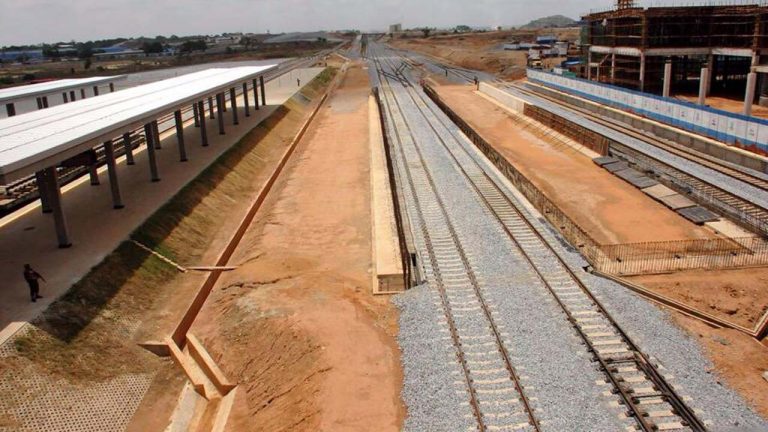The vigour with which the present administration is pursuing the railway modernisation program is quite commendable. The commitment of the Minister of Transportation Rotimi Ameachi in following up on the project leaves no one in doubt that the project is on track and that Nigerians in no distant time would begin to enjoy the full benefits of the railway modernisation programme.

The railway modernisation initiative in Nigeria is designed to complement the existing narrow gauge system with the wider standard gauge system, while allowing high-speed train operations on the railway network in future.
The contract for the Lagos-Kano standard gauge modernisation project awarded to CCECC in 2006 marked the beginning of the initiative.
However, the project couldn’t be implemented due to funding problems. It was later re-scoped into different standalone segments.
The Abuja-Kaduna segment was the first to be implemented as part of the Lagos-Kano standard gauge project.
The next segment to follow in line is the 156km-long Lagos-Ibadan rail line, which is due to be delivered soon. The Lagos- Ibadan Standard Gauge, rail line was flagged off at Ebute-Metta Junction, Lagos in March 2017 by Vice President Yemi Osinbajo.
Police kill 17 bandits, recover 189 rustled animals in Katsina
The 36 months Lagos-Ibadan rail project is expected to bring succour to commuters between Lagos the commercial capital of Nigeria and Ibadan, one of the oldest cities in the country.
The project has suffered a lot of delays as a result of additional works and extension of the line by five kilometres from Ebutte Metta to Apapa port.
The project has also suffered unanticipated impediments. These impediments are majorly in built-up areas especially from Iju down to Apapa port. These are built-up areas and over time most of the land belonging to the Nigerian Railway Corporation, NRC, has been encroached on. Paying compensation and clearing the area has not been an easy task for the Corporation.
Apart from residential buildings, the contractor has to contend with underground pipelines and cables. In one report, about 34 kilometres of pipes had to be relocated last year before work could commence.
There were also high tension power lines, overhead bridges, and several other structures.
This is not to talk of telecommunication cables and water pipelines. These underground and above ground networks of cables and pipes have to be carefully relocated to avoid service disruptions. CCECC reportedly had to engage the services of experts to accomplish this task.
Evidently, these kinds of impediments cause unavoidable delays.
In his last inspection visit, the Minister of Transportation Rotimi Amaechi observed these impediments first hand and said he would schedule a meeting with the management of Nigeria Port Authority (NPA) so as to find a lasting solution to the challenges encountered during construction on the Ebute-Metta to Apapa route.
The meeting expectedly would also look at the challenges encountered by the CCECC in clearing materials meant for the stations
It is also imperative to add that, the Federal government in line with its policy review has over time reviewed the scope of the project in line with contemporary realities. Investigation further reveals that there are additional works which were not in the original rail contract.
The original scope of the contract starts from Ebute Meta (Lagos) to Ibadan and was approved by the Federal Executive Council on July 18, 2012, after the issuance of Certificate of No Objection by the Bureau of Public Procurement (BPP) ref. no. BPP/S. 1/vol. VII/09/221.
The need to incorporate the ports especially Apapa port into the rail network brought about approval for an extension and addendum 2A that starts from Ebute Meta to Lagos Port Complex, Apapa.
The additional work was approved by Federal Executive Council on November 30, 2016, after obtaining BPP No Objection ref. no. BPP/S. 1/vol. XII/16/053 of September 08, 2016.
It is significant to note that while the original contract was signed in 2012 by the Goodluck Jonathan administration, the extension to the port was approved by the Federal Executive Council led by President Mohammadu Buhari, four years later in 2016. The project was eventually flagged off in 2017 by vice president Yemi Osinbajo in March 2017.
There is also the need for Nigerians to begin to understand the size and enormity of the project. The actual length of the Lagos Ibadan rail line is 386km as against the 156km generally assumed by most media reports. 156km represents the length between Lagos to Ibadan, however, the project is a double-track railway line which means you have to multiply the actual length by two.
Railway projects, like the Lagos to Ibadan network, are complex projects requiring detailed planning and high technology. It is not just the laying of tracks. Track laying is only a part of the entire system.
The Lagos to Ibadan railway project, for instance, consist of 21 Railway bridges with an overall length of 12.43km; 40 Vehicular overpasses or flyovers and 27 pedestrian bridges.
Most of these bridges and overpasses represent additional works, which became imperative as a result of government policy that anywhere railway line passes through populated residential areas, provisions must be made for overpasses and pedestrian bridges.
The project also consists of ten stations of which three are mega stations with capacity to handle 4000 to 6000 passengers at peak hours and seven other standard class stations. Also, noteworthy is the construction of a wagon factory in Kajola by the contractor.
The project has its own power supply with a 33kv dedicated power supply from the national grid with 4 substations and 200km approximate length of distribution line. There is also Signalling and Communication network, for smooth communication within the network.
These massive and standalone works are component parts of the railway project which the contractor must oversee and deliver promptly for the effective and full take-off of the Lagos to Ibadan railway line.
The Minister of Transportation, Rotimi Ameachi, must be commended for the zeal and consistency he has brought to the execution of the project by ensuring adequate funding and strict monitoring. His monthly monitoring of the project is novel and shows the administration’s commitment to the railway modernisation program.
He has also mounted significant pressure on the CCECC to ensure that the project is delivered possibly before the scheduled date of completion.
The attention the Minister has given to the project is paying off. As at November last year, the rail line between Iju to Ibadan was already in operation, offering a free ride to commuters especially during the last Christmas and New Year festivities.to date, the free ride service is still in place
The CCECC opened the line to commuters in line with a directive by the minister. That the rail line could go into operation between Iju and Ibadan is a clear indication that significant progress has been achieved in the full delivery of the project.
As early as January this year Managing Director, Nigerian Railway Corporation (NRC), Mr Fidet Okhiria while speaking with the media commended the CCECC and said the project was ahead of schedule and that there was no hitch in the execution of the project.
“There is no hitch. We are moving on and everything is moving well. The fact is that the minister wants them to finish before the time. The contractor is saying that it wants to keep to the time. However, we are still ahead of the scheduled time.” He said.
While the honourable Minister of Transportation may want the project completed before schedule, he equally agrees that this may not be possible as a result of additional works and other realities:
“The original time for the contract is May. They made an argument you cannot fault, that they were given additional work of six months. And if you add an additional six months to that time, you are talking about next year. So, instead of looking at the law, look more on practicality and compel them to speed up.
“By the time we met yesterday, I realised it is not important I talked about the law, but what of the additional work in stations, tracks, underpasses, flyovers and literally everything affected the time of completion.
“Somebody advised me not to talk about the completion date anymore and just continue working.”
Whether the Minister chooses to work quietly or openly, one thing is evident, he has brought an unusual zeal and candour to the railway modernisation project of the federal government and the evidence speaks for itself.








Leave a Comment
You must be logged in to post a comment.